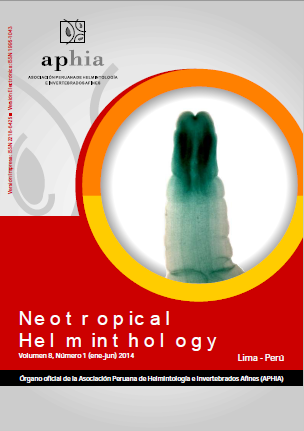ECOLOGICALASPECTS OF PARASITIC HELMINTHS OF LORNA DRUM SCIAENA DELICIOSA (TSCHUDI, 1846) (PERCIFORMES: SCIAENIDAE) ACQUIRED AT THE FISHING TERMINAL OF VENTANILLA, CALLAO, PERU
DOI:
https://doi.org/10.24039/rnh201481899Keywords:
Cynoscionicola, Corynosoma, Dycheline, Helicometra, parasitare ecology, Sciaena.Abstract
The aim of this study was to assess the ecology of helminth parasites from 35 Sciaena deliciosa of the Terminal of Fish from Ventanilla, Peru during the months of January to May 2013. The parasites were collected and evaluated using standard protocols. The four most prevalent parasites and mean abundance were Cynoscionicola sciaenae (Tantaleán, 1974) (Monogenea); Helicometra fasciata (Rudolphi, 1819) (Trematoda), Dycheline (Cucullanellus) amaruincai (Freitas, Vicente & Ibañez, 1969) (Nematoda) and Corynosoma obtuscens (Lincicome, 1943) (Acanthocephala). Endoparasites predominance on ectoparasites was observed. All five helminths showed with aggregation indices a clumped distribution and only Hargicotyle louisianensis (Hargis, 1955) Mamaev, 1972 (Monogenea) was evenly distributed. The prevalence and abundance of D. amaruincai and Diphyllobothrium pacificum (Nybelin, 1931) (Cestoda) were correlated with the total length of the host. The sex of S. deliciosa was observed to be related to the prevalence and abundance of D. amaruincai. Regarding the relative condition factor (k ) n only fish parasitized by C. sciaenae and ectoparasites had higher values compared with nonparasitized. Infective stages of Anisakis sp, C. obtuscens and D. pacificum were also found with zoonotic importance on the Peruvian coast. The monogeneos H. louisianensis and Macrovalvitrema sp. are considered new records for the Peruvian coast.
Downloads
Published
How to Cite
Issue
Section
License
Copyright (c) 2021 Neotropical Helminthology

This work is licensed under a Creative Commons Attribution-NonCommercial-NoDerivatives 4.0 International License.
OBJETO: El AUTOR-CEDENTE transfiere de manera TOTAL Y SIN LIMITACIÓN alguna al CESIONARIO los derechos patrimoniales que le corresponden sobre la (s) obra(s) tituladas: xxxxxxxxxxxxxxxx, por el tiempo que establezca la ley internacional. En virtud de lo anterior, se entiende que el CESIONARIO adquiere el derecho de reproducción en todas sus modalidades, incluso para inclusión audiovisual; el derecho de transformación o adaptación, comunicación pública, traducción, distribución y, en general, cualquier tipo de explotación que de las obras se pueda realizar por cualquier medio conocido o por conocer en el territorio nacional o internacional.
REMUNERACIÓN: La cesión de los derechos patrimoniales de autor que mediante este contrato se hace será a título gratuito.
CONDICIONES Y LEGITIMIDAD DE LOS DERECHOS: El AUTOR-CEDENTE garantiza que es propietario integral de los derechos de explotación de la(s) obra(s) y en consecuencia garantiza que puede contratar y transferir los derechos aquí cedidos sin ningún tipo de limitación por no tener ningún tipo de gravamen, limitación o disposición. En todo caso, responderá por cualquier reclamo que en materia de derecho de autor se pueda presentar, exonerando de cualquier responsabilidad al CESIONARIO.
LICENCIA DE ACCESO ABIERTO: El AUTOR-CEDENTE autoriza que manuscrito publicado en La Revista Neotropical Helminthology permanece disponible para su consulta pública en el sitio web https://www.neotropicalhelminthology.com/ y en los diferentes sistemas de indexación y bases de datos en las que la revista tiene visibilidad, bajo la licencia Creative Commons, en la modalidad Reconocimiento-No comercial- Sin Trabajos derivados –aprobada en Perú, y por lo tanto son de acceso abierto. De ahí que los autores dan, sin derecho a retribución económica, a la Asociación Peruana de Helmintología e Invertebrados Afines (APHIA), los derechos de autor para la edición y reproducción a través de diferentes medios de difusión.


 Numero 2 Volumen 19 - 2025 (versión Anticipada)
Numero 2 Volumen 19 - 2025 (versión Anticipada)














































